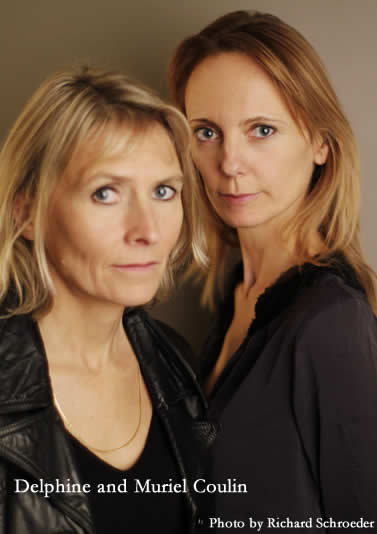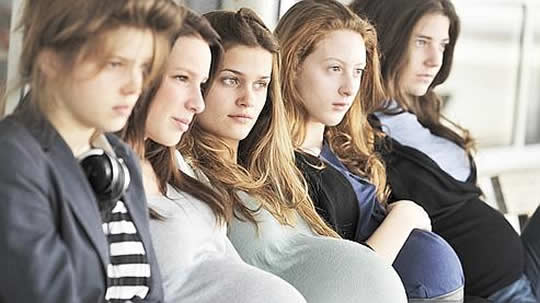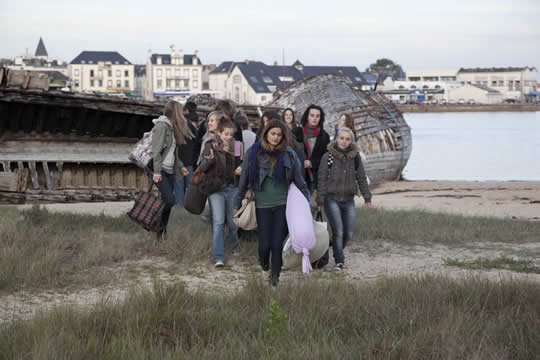 17 Girls is based on a headline-grabbing incident in the U.S., sister directing duo Delphine and Muriel Coulin’s provocative debut feature – which they also co-wrote – follows the fallout in a sleepy French coastal town of Brittany, when a group of 17 teenage girls from the same high school all decide to become pregnant at the same time, an act at once unexpected and incomprehensible to the adults and the boys in their world.
17 Girls is based on a headline-grabbing incident in the U.S., sister directing duo Delphine and Muriel Coulin’s provocative debut feature – which they also co-wrote – follows the fallout in a sleepy French coastal town of Brittany, when a group of 17 teenage girls from the same high school all decide to become pregnant at the same time, an act at once unexpected and incomprehensible to the adults and the boys in their world.
17 Girls one of the new French films at 2012 COL*COA Film Festival, has been directed by sister filmmakers Delphine and Muriel Coulin.
Bijan Tehrani: How did you come about the story of 17 Girls?
Muriel Coulin: I read two lines in a French Newspaper and it was on a day that stated that there were seventeen girls in the same school that decided to get pregnant together. As soon as I read those two lines, I said to my sister that this is an incredible story and we should make something out of it; we knew there were many themes that we could explore in a long feature film.
BT: Did you research the story itself or did you come up with your own version of it?
MC: Sometime it is good to have two directors because we share the work; I read everything that I could read from papers and the Internet, and I looked on television as well. My sister, who is a short term novelist, she decided not to know anything about the real facts and once we started the writing process we would then share what I read and what she imagined about the facts and we made a combined script with our information and our own story was born through our own time and imagination. In fact, what we made contained very few facts from the original story, there are only two or three things and the rest is purely imagined.
BT: Do you think that this film is something that teenagers today will identify more with or is this something that the older generation will identify more with?
MC: My sister and I are around forty years old and we tried to go back in those years when we were teenagers and tried to bring back the feelings that we had at the time, so again we wanted the film to be universal. I think the feelings that you have at that age are very special and I think that the feelings, whether it was twenty years ago or even 100 years ago, the feelings are the same. The conditions change, the way of life changes, but I think that the feelings remain the same. I think that any woman and man can at some point identify with the feelings at that stage where you can be very happy one minute and the next minute you can be completely desperate.
BT: The film bridges most of the time between drama and humor and it blends very nicely. How did you manage to blend these two themes together?
MC: It was quite difficult actually, but at that age you can go from a lot of happiness to complete despair, so this blending was important to us when we began writing the script, that we could have those antagonist feelings, but also some comedy. My sister and I love the Italian comedies, for instance. The Italian comedies from the 50’s and 60’s had stories where they could be very sad while at the same time being very funny, and we wanted to include this characteristic. The characters will go on telling jokes and behave very happy and simple even though there are sad themes, so I love the contrast between those. We say, sometimes, that when you go to bury, you can encounter something very funny that you do not expect, and life is like that. We wanted to show that in our film as because we love that kind of mixed feeling.
 BT: How did you go about casting the film?
BT: How did you go about casting the film?
MC: It was a very long process which lasted 9 months, from September to May and we saw many candidates. Most of them were non-professional. We recruited from ads in McDonalds and colleges and we saw about 600 girls. We wanted to find girls that would fit the characters that we had written, but then of course we had to bring them all together and see how they worked. When we first brought them all together, they looked like statues; they did not talk, they did not look, they did not hear anything together, and so we started the long process of bringing them together. We took them to restaurants together, bringing them to the beach and driving around together, things like that to help them discover each other and, once we started to see them, we saw that they clicked with each other very deep inside. There was something very genuine and cunning coming from each of these girls.
BT: How was the transition from making short films to making a feature film?
MC: Everybody tells me that a short film is a really long feature film and, in fact, I think people lie to you when they say that because the medium is completely different. Short film is a matter of friends doing a film together with the very little money and means that they have with them, but a long feature for us started with getting great women. We had to deal with the girls, we have to be the manager of a team, you have to deal with money, you have to be aware of everything that is going on, and people keep on asking questions from 6 in the morning to midnight! I mean, for us, it was a completely different way of thinking. It was more professional and we enjoyed that a lot, but we did not expect it to be that big, but it was a great experience.
BT: How did you come up with the visual style of the film?
MC: We worked in advance with the DP, and we had prior experience with him. The cinematography was clear to us before we started shooting because we had spoken about the color and the shots, and we knew from the beginning what we wanted to film. We wanted pastel colors early on, and then as we went along in the film, we had more greys and more darks and more contrast. We wanted to create a landscape that was very small, where the horizon would always lead to another life or another future, something like that. We were inspired by documentary films and our past experiences.
BT: What was it like working with another director on the same film? Particularly, what was it like working with your sister?
MC: We always have been very close to each other, so there is no real difficulty. My sister is a novelist and she has been writing for a long period, so people are always thinking that she is writing the script and I am operating the camera, but in fact it is not like this at all. She takes the camera as much as I take it and we both contribute to the script, so it is almost completely informal and I say that we share the film 50/50; the writing to the end and the editing, and even the promotion of the film we share together. Today, she is not here because she is pregnant actually. It was a funny thing about the film because it was about pregnant girls and now she is pregnant, but we have been sharing everything about this film from the very beginning. There is very little tension between the two of us—it can happen, but it is very rare.
BT: Any future projects lined up?
MC: Yeah, we are working now on another project. We are in the treatment stage, so it is too early to talk precisely about it, but we are writing a new film.
